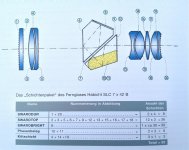Bruce,
I double checked and my ED3's were as I described - definitely magenta coatings on the objectives - looks like your photo of your Bushies.
Anyone have any concrete info on the number of coating layers for the dielectric mirror on the Bushie ?
..........
Chosun :gh:
Well, it looks like Zen Ray did a midstream coating change with the ED3. That may explain why we differ on what we see for color balance.
Legend M Coatings:
The Bushnell web site for the Legend M shows either symbols or states the following coatings.....
- Di-electric coatings
- Ultra wide band coating
- RainGuard HD water repellent lens coating
In addition, the side of the box says ......
- Fully multicoated optics
Strange to say, they make no mention of phase coating but I think it is safe to assume based on performance and price that it has phase coating. I noticed more sites do not mention it any more since they think that is assumed.
Knowing how much you like marketing hype (

), here is what I found on the Bushnell web site:
DIELECTRIC PRISM COATING: Dielectric coating on the prisms improves reflectance to greater than 90 percent. The result is a deeper, richer and more reproducible color images.
ULTRA WIDE BANDCOATING: This anti-reflection coating process that is customized for every lens element in the optical path, in order to allow the best possible light from the front glass all the way back to the eyepiece. The result is maximum brightness and true color across the light spectrum.
Rainguard® HD: The only state-of-the-art, patented and proprietary hydrophobic and oleophobic lens coating keeps water, fog and oily fingerprints from wrecking your vision. Water drops from rain, snow, sleet and even your own breath bead up into much smaller droplets that scatter less light. Ensuring that you never miss your moment.
PC3 Phase Coating: Our exclusive PC3 Phase Coating is applied to bring each image into sync after it has been halved and rejoined once it has been previously split in a roof prism optical system.
Fully Multi-Coated Optics: All air-to-glass surfaces feature multiple layers of anti-reflective coating. Fully multi-coated optical systems deliver the brightest, highest-contrast images with the least amount of eye strain because only a very small percentage of light is lost before it reaches the viewer's eye. (Part of the fully multicoated designation)
And now for the part you have been waiting for ..........
XTR Technology: Our exclusive XTR technology utilizes 60 layers of coatings on each prism that conserves, harnesses and optimizes the available light. XTR delivers a world-leading 99.73 percent light transmission per lens for a combined light transmission of 90 percent. (Part of the fully multicoated designation)
The web site and the box do not state XTR technology for the Legend M but the box does say fully multicoated and the XTR description on the web site includes the fully multicoated icon. So, there are dots to connect that the Legend M has XTR coating but that is an assumption. Don't you just love the marketing folks that put all of this together for us in such a clear understandable prsentation. 3









